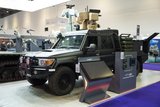Harris to develop narrowband SRW
Harris Corporation will develop a new narrowband mode of the Soldier Radio Waveform (SRW) for the US Department of Defense under a three year contract from the National Spectrum Consortium announced on 11 January.
The new narrowband mode will decrease the amount of spectrum required when deploying an infantry brigade combat team, extending point-to-point communications range, providing electronic counter-countermeasures, and enabling reliable voice and data communications transmission over varying terrain.
The narrowband mode, which will be included on all US Army programme of record tactical radios, will complement the wideband SRW which is used to transmit higher bandwidth information, such as video and images over shorter point-to-point distances.
The narrowband mode of SRW will also enhance network scalability, allowing more users – including other US services and coalition partners – on the network without degrading reliability or performance.
Chris Young, president, Harris Communication Systems, said: ‘The new narrowband waveform is part of the US Army’s continued modernisation efforts that are providing warfighters with ever-increasing capabilities. The Harris team will apply our expertise in waveforms and tactical radios to develop and deliver this needed waveform to warfighters on the battlefield.’
More from Digital Battlespace
-
![Babcock nears first customer for Nomad AI translation tool]()
Babcock nears first customer for Nomad AI translation tool
Nomad can provide militaries with real-time intelligence, saving critical time on the battlefield.
-
![AUSA 2025: Israel’s Asio Technologies to supply hundreds of improved Taurus tactical systems]()
AUSA 2025: Israel’s Asio Technologies to supply hundreds of improved Taurus tactical systems
Taurus operates alongside the Israel Defense Forces’ Orion system which supports mission management across tens of thousands of manoeuvring forces, from squad leaders to battalion commanders.
-
![AUSA 2025: Kopin pushes micro-LED plans as China moves faster]()
AUSA 2025: Kopin pushes micro-LED plans as China moves faster
The plan for the new displays follows fresh investment in Kopin’s European facilities by Theon and an order for head-up displays in fielded aircraft, with funding from the US Department of Defense.
-
![AUSA 2025: Persistent Systems to complete its largest order by year’s end]()
AUSA 2025: Persistent Systems to complete its largest order by year’s end
Persistent Systems received its largest ever single order for its MPU5 devices and other systems earlier this month and has already delivered the 50 units to the US Army’s 4th Infantry Division.
-
![Aselsan brings in dozens of companies and systems under the Steel Dome umbrella]()
Aselsan brings in dozens of companies and systems under the Steel Dome umbrella
Turkey has joined the family of countries attempting to establish a multilayered air defence system with government approval in August 2024 for the effort landed by Aselsan. Dubbed Steel Dome, the programme joins Israel’s Iron Dome, the US Golden Dome, India’s Mission Sudarshan Chakra and South Korea’s low-altitude missile defence system.
-
![DSEI 2025: MARSS unveils new agnostic multidomain C4 system]()
DSEI 2025: MARSS unveils new agnostic multidomain C4 system
MARSS’ NiDAR system has been deployed using sensors from static platforms to provide detection and protection for static sights, such as critical infrastructure, ports and military bases.




























